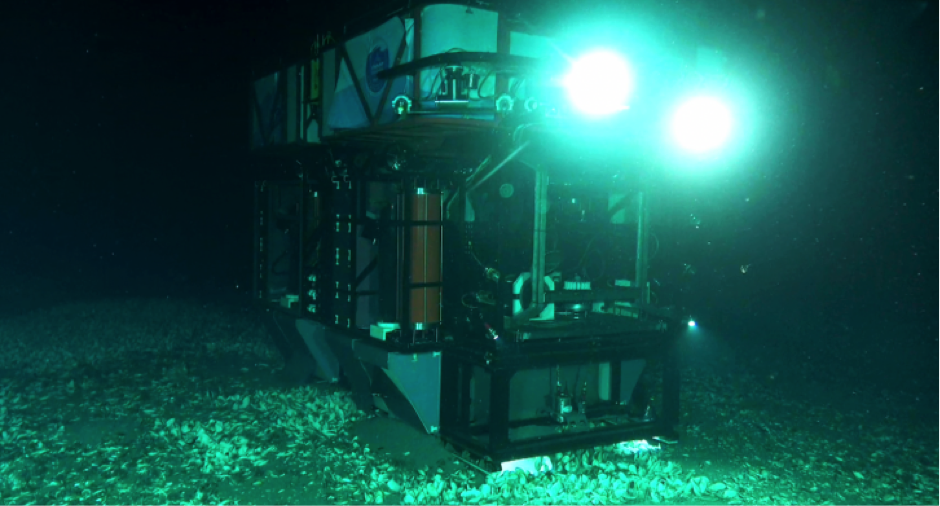In the showcase of China's first deep-sea themed creative design competition in 2022, one couldn’t help but be surprised to see a conceptual model of a blunt-mouthed lionfish-like future submarine soft-bodied robot.
As a science fiction genre, using fish-shaped cyborgs to monitor the sea is not the first time it has appeared in the Chinese cultural imagination towards the ocean. In a 1979 fiction, Shark Scout, by Chinese author Zheng Wen-guang, live sharks were imagined as biological resources that could be technologically modified to enable human surveillance of the deep seas. As Zheng writes,
Suddenly, a colourful underwater world appears on the TV screen: coral clumps as red as blood, white sand dunes, giant kelp and oddly shaped fish swimming among them… The strange thing is that the view of the seabed changes very quickly, as if the person holding the camera is swimming at a very high speed…
Professor Yang casually turned off the television. “What we have sewn into the shark’s head is not a camera, nor a videographer, but a detector. It certainly doesn’t have a lens because the shark’s eyes are its lens. What you are seeing is the view from the eyes of shark No.7, which is swimming near your island. What you see under the water is reflected in the retina of the shark’s eye, which in turn is transmitted to its cerebral cortex, where some weak electrical currents called bioelectricity is immediately generated. Our detector amplifies this bioelectricity, reduces its frequency and sends it through the seawater to the TV screen. Understand? Think about it: the sea floor is pitch-black, and if we were to dive that deep ourselves, we wouldn’t be able to see anything without lighting. But the shark’s eyes are very sharp. Look how clearly it sees everything under the sea! Isn’t it fitting to use it as a scout of the sea?” (Translation by the author)

Figure 1. Blunt-mouthed lionfish-like future submarine soft-bodied robot
Image credit: Art.China
Beyond the imaginative spectacle, at stake is the ever-expanding human monitoring of the oceans – how does this play into the global ocean debate? In China’s Deep-sea Exploratorium,[2] the seafloor observation network is described as “an all-weather, real-time, continuous, safe and long-term observation of the ocean… It is not only a basic research issue for marine science and technology, but also closely integrated with national defence, resources, and environment etc.” Let’s return briefly to the Shark Scout’s mission: militarised reconnaissance and monitoring of the oceans. In these texts, we can see an emerging framework for understanding the oceans being constructed through human monitoring and control of the deep sea. China, of course, is not the only entity that pays for this framework. In fact, a race to monitor the oceans is in full swing throughout the global north. For example, the United States, Canada, Europe, and Japan have already installed deep-sea monitoring networks in their neighbouring waters in the Atlantic, Pacific and Mediterranean respectively (Figure 2).

Figure 2. Canadian deep-sea monitoring network “NEPTUNE-Canada”
Image credit: Photograph by the author at the China Deep-sea Exploratorium
In “New High-Tech Flexible Networks for the Monitoring of Deep-Sea Ecosystems,” deep-sea scientists Jacopo Aguzzi et al. argue, “the need for a global observing effort in the deep ocean is crucial… since the human footprint on the ecosystems of the global ocean is rapidly expanding toward great depths” (2019, p.6617). As parts of this global monitoring system, high-technology approaches such as “High-Tech Cable Observatory Networks,” “Spatial Monitoring Capability with Permanent Mobile Platforms,” “Benthic Networks Growing in the Pelagic Realm” and other high-technical applications are growing while creating impacts on the scientific discourses in academia. Many deep-sea technology researchers, including Aguzzi, claim:
The output from such a monitoring regime will support decisions of policy makers, allowing them to assess the impacts of increased industrial activities and pressures on deep-sea ecosystems (e.g., oil or gas extraction and mining or trawl fishing), including a better assessment of already evident but poorly quantified climate change impacts at great depths. (2019, p.6627)
A similar technology is known in China as “in-situ monitoring,” which is the use of sensors, collectors and communicators to monitor the seabed and deep sea in an automated, electronic, digital and networked manner, providing continuous, dynamic, panoramic and real-time updated data. In October 2022, the Chinese research vessel Exploration II and its manned submersible Deep Sea Warrior completed a series of sea trials in the South China Sea, during which researchers successfully set up a large-depth in-situ scientific experiment station on the seafloor (Figure 3). Through this station, China is expecting to conduct long-cycle unmanned scientific research in the near future. According to Chen Jun, an associate researcher at the Institute of Deep-sea Science and Engineering, Chinese Academy of Sciences, “Deploying an in-situ scientific experiment station on the seafloor is equivalent to moving the entirety of the testing and analysis instruments from the laboratory on land to the seafloor” (As cited in Zhu, 29th October 2022). As it stands, China does not yet have a fully developed deep-sea monitoring network equivalent to that of the US, Canada and Japan. Nevertheless, DSM in Chinese research has gained momentum and created a narrative that encourages a race to develop deep-sea science and technology, which is often articulated to China’s potential competitiveness in mining deep-sea resources. In an online article “Typologies of Marine Environmental Monitoring and Its Trends,” the authors clearly state:
Deep-sea monitoring systems have emerged as a research hotspot in marine technology. Visualised, real-time, long time series monitoring of the deep-sea environment is of great significance to the study of the mineralogenic mechanism, exploitation conditions and environmental impacts of marine mineral resources, as well as to the study of deep-sea organisms and their genes. (Chinese Aqua Network, 2019)
Yet we cannot help but question the unidimensionality of the relationship between technology and ecology that this discourse exposes. In thinking about the potential harm of DSM, Susan Reid (2023) suggests that deep-sea exploration techniques such as sonar may stir up and disrupt the oceanic soundscape, thereby disturbing the energy networks and biodiversity within it. More importantly, however, humans’ panoramic monitoring of the deep seas may create an extractivist framework that goes well beyond the expectations of ‘protecting ecosystems.’ Captured in the Chinese scientific and academic sphere, deep-sea monitoring is on the one hand “a symbol of a country’s overall national power and scientific and technological strength” while on the other hand “driven by the exploration of undersea oil and gas resources, mineral resources, pharmaceutical resources and genetic resources” (Sun Song 2017, p.1488-1492). Realising that the global extractivist framework has been consolidated by UNCLOS’s instrumentalising legal discourses and dispositifs (Foucault 1980, p.194-195) of abstraction, we should not ignore that the emergence of deep-sea monitoring technologies may be creating a deep-sea panopticism that projects human power and extends the capitalist exterior. Here, technologies, knowledge, and values have interacted inextricably to construct an ideology, a comprehensive set of ideas by which different human entities make sense of deep-sea surveillance. Given China’s growing presence in global oceans through the 21st Century Maritime Silk Road, the question of whether deep sea monitoring technology will be an upcoming target for Chinese infrastructure investment in its cooperating countries along the MSR requires more urgent consideration.
We might need a submerged planetary perspective that invites us into another framework of perception that leaves extractivism behind. As Reid borrowed from cultural theorist Macarena Gómez-Barris, this can be the concept of blurring (Reid, forthcoming in 2023). As Reid argues, a ‘submerged perspective’ offers ‘blurry counter visuality’ as a conceptual strategy to smudge out the certitude of dominant regimes and thereby create the space in which alternatives might be imagined (Gómez-Barris 2017, p.15 cited in Reid, forthcoming in 2023). Conversely, the panoramic view offered by deep-sea surveillance inevitably provides a seductive visuality. As in the two Hollywood blockbusters released in 2022, Avatar: The Way of Water and Black Panther: Wakanda Forever, deep-sea resources once discovered, regardless of living and non-living, are exposed to the endless and desperate controversy of being extracted or waiting to be extracted.
References
Aguzzi, J., Chatzievangelou, D., Marini, S., Fanelli, E., Danovaro, R., Flögel, S., Lebris, N., Juanes, F., De Leo, F. C., Del Rio, J., Thomsen, L., Costa, C., Riccobene, G., Tamburini, C., Lefevre, D., Gojak, C., Poulain, P.-M., Favali, P., Griffa, A., … Company, J. B. (2019). New High-Tech Flexible Networks for the Monitoring of Deep-Sea Ecosystems. Environmental Science & Technology, 53(12), 6616–6631. https://doi.org/10.1021/acs.est.9b00409
Cameron, J. (2022). Avatar: The Way of Water. 20th Century Studios.
Coogler, R. (2022). Black Panther: Wakanda Forever. Walt Disney Studios Motion Pictures.
Foucault, M. (1977). Discipline and Punish: the birth of the prison. New York: Pantheon Books.
Gómez-Barris, M. (2017). The Extractive Zone: Social Ecologies and Decolonial Perspectives. Duke University Press. https://doi.org/10.1515/9780822372561
Reid, S. (Forthcoming in 2023). Stirring and Deranging: Oceanic Energy Relations and Extractivism.
Sun, Song. (2017). Cognition and Practice on Marine Sciences. Oceanologia et Limnologia Sinica, 48(6): 1488-1492.
Unknown. (2019). 海洋环境监测的类型及其发展趋势 (Typologies of Marine Environmental Monitoring and Its Trends). 中国水网 (Chinese Aqua Network). Retrieved April 24, 2023, from https://www.h2o-china.com/news/300169.html
Zheng, W. (1979). Shayu Zhenchabing (鲨鱼侦察兵, The Shark Scout), first edition. Beijing: Zhongguo Shaonian Ertong Press, 1979.
Zhu, Y. (2022). China’s successful deployment of a “subsea experimental station” will enable long-period unmanned scientific research in the deep sea. 我国成功布设”海底实验站” 将实现深海长周期无人科考_滚动新闻_中国政府网. Retrieved April 24, 2023, from http://www.gov.cn/xinwen/2022-10/29/content_5722522.htm
Notes
[1] From 2021 to 2022, the Beijing Foundation for Contemporary Art has invited the Communication Centre of the China Association for Science and Technology, the China Shipbuilding Engineering Society, the Seventy-second Research Institute of China Shipbuilding Group Corporation, the Deep Sea Technology Innovation Centre of Hainan Province and other deep sea-related professional institutions as co-organisers to launch the first China Deep Sea Innovation and Design Exhibition for the whole Chinese public society. The theme of this innovative design competition is “Into the Deep Sea,” which aims to open up a novel public discourse in the fields of marine welfare design, underwater equipment innovation, deep-sea cultural communication and creativity.
[2] It is the only museum in China dedicated to the deep seas and is located on the campus of Tongji University in Shanghai. The venue aims to educate the public about the biology, science and culture associated with the deep sea, providing a Chinese perspective on the narrative of the deep sea.

Figure 3. China’s Submarine Experiment Station


